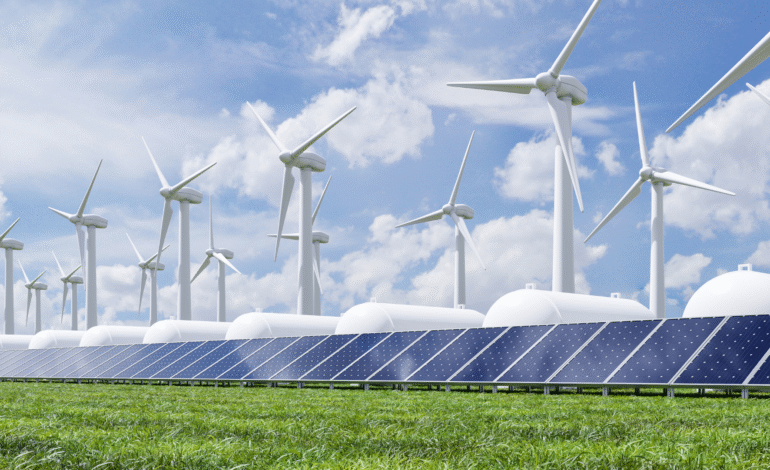Ukraine’s $40 Billion Climate Strategy Shapes 2030 Future

In an era where environmental sustainability is no longer optional but essential, Ukraine has laid the foundation for its green transformation with the National Energy and Climate Plan (NECP). The ambitious plan charts the nation’s course through 2030, aiming to align its energy system with international climate goals. It reflects Ukraine’s intent to modernize infrastructure, reduce emissions, and transition toward a clean and efficient energy ecosystem. Designed with sustainability at its core, the NECP brings together environmental and economic strategies into a harmonized vision for a better, greener tomorrow.
The NECP is more than just a document. It is a national commitment. Since its approval by Ukraine’s Cabinet of Ministers in June 2024, it has become a guiding blueprint for efforts to reform the country’s energy system, enhance environmental performance, and foster growth through climate-conscious development. Ukraine’s efforts are a signal to the world that sustainable ambition is alive, even during challenging times.
The NECP Framework: Bridging Energy Goals With Climate Commitments
At the heart of Ukraine’s NECP lies a synergy between clean energy development and responsible climate action. The framework outlines six main priority areas requiring focused investment and coordinated action. These include renewable energy development, energy efficiency enhancement, reduction of greenhouse gas emissions, energy security improvement, market integration with the European Union, and innovation in clean technologies.
These six areas interconnect to form a resilient foundation for long-term progress. The plan recognizes that climate transformation is not about isolated policy changes but rather integrated strategies that evolve together. Through this well-structured approach, Ukraine aims not just to adapt to climate change but to lead with progressive reforms.
The roadmap to achieving the goals of the NECP by 2030 is ambitious but achievable—with approximately $40 billion in investment needed. This number reflects a future of investment in jobs, innovation, clean air, energy access, and a healthier environment for generations to come.
Funding a Future: The Role of Global Financial Partnerships
Financial support for Ukraine’s energy and climate transformation is expected to come from diverse international partnerships. Deputy Minister of Economy Andriy Teliupa recently highlighted the core funding sources during a strategic energy conference. Among the key contributors is the Ukraine Facility program, offering grants and loans under its Pillar II scheme, totaling around €9.3 billion.
Bilateral agreements and strategic cooperation with countries and institutions committed to climate goals provide additional resources. The involvement of international financial institutions also opens doors to structured and secure funding, supporting both public and private sector implementation. These partnerships help ensure that investment is not just transactional but transformational, enabling knowledge transfer, technical expertise, and institutional strengthening.
Moreover, government initiatives within Ukraine have been designed to foster transparency and long-term sustainability in the funding model. This layered approach to financing builds confidence among stakeholders and demonstrates that the nation is taking both environmental and fiscal responsibility seriously.
High-Level Talks and Unity for a Sustainable Tomorrow
On April 16, 2025, a pivotal meeting of the High-Level Advisory Group (HLAG) was held, focusing on the implementation of the NECP. The gathering featured representatives from the Government of Ukraine, the European Commission, the Energy Community Secretariat, and other prominent international stakeholders. Together, they reviewed the progress made so far and discussed the challenges still to overcome.
This high-level dialogue is a testament to Ukraine’s commitment to open collaboration and international standards. It reflects a unified vision shared across borders—where environmental success is built not in isolation but through partnerships and mutual accountability.
Such events underscore the increasing relevance of climate action in diplomatic conversations. Ukraine’s willingness to engage with its peers and coordinate efforts with global institutions provides an encouraging sign of long-term sustainability.
Tracking Progress: How Ukraine Measures Environmental Achievements
One of the standout elements of Ukraine’s NECP implementation is the rigorous, independent monitoring process being conducted alongside the official assessments. Roman Nitsovych, Research Director at DIXI Group, shared insights into how the country is evaluating the effectiveness of its policies.
The monitoring framework evaluates 205 different indicators, covering both the actual status and the degree of progress of each policy. This dual-layered review helps paint a comprehensive picture of where things stand and where they are headed.
Ukraine’s integrated reporting mechanisms, including the detailed submission to the Energy Community Secretariat in March 2025, demonstrate the country’s transparency and adherence to international best practices. Every detail—across 20 annexes—has been submitted with diligence and clarity, reinforcing Ukraine’s role as a proactive and responsible participant in the global climate mission.
Pillars of Progress: Transformative Policies and New Initiatives Launched
Several notable policies and decisions mark Ukraine’s progress since the NECP’s implementation. These include the restoration of mandatory greenhouse gas emissions monitoring and the development of an action plan for an emissions trading system. The country is also advancing efforts in construction efficiency, introducing optional requirements for near-zero energy buildings (NZEBs).
Equally promising is the initiative to establish minimum stockpiling levels for crude oil and petroleum products. This move ensures energy security while enhancing Ukraine’s readiness to handle energy disruptions—a vital component in building a resilient energy system.
These reforms are more than bureaucratic changes; they are tangible shifts that improve lives. With better data, structured emissions trading, efficient buildings, and stable fuel reserves, Ukraine is gradually evolving into a model for environmental progress in the region.
Innovation and Sustainability: Greener Buildings, Cleaner Energy, Better Living
The drive toward sustainability has permeated multiple sectors, and Ukraine’s approach to greener infrastructure is a key element of that vision. The embrace of NZEBs represents a forward-thinking step toward reducing energy consumption while improving comfort and quality of life for citizens.
Moreover, the emphasis on energy-efficient technologies, smart grids, and low-emission transport is creating a new market for innovation. Entrepreneurs, startups, and established businesses are beginning to align their goals with Ukraine’s national climate vision, opening doors to economic diversification and clean-tech job creation.
As these technologies mature and policies stabilize, Ukrainians can look forward to homes and cities that are more energy-efficient, affordable, and environmentally responsible. Such a transformation also builds public support, making climate goals not just achievable but widely embraced.
Path to 2030: A Nation’s Journey Toward Climate Resilience
Ukraine’s path to achieving its NECP goals by 2030 is defined by careful planning, strategic investments, and inclusive progress. Each decision made now is a step toward a resilient and adaptive future.
Even in the face of considerable challenges, Ukraine has demonstrated that environmental ambition need not be sidelined. Instead, it can be integrated into every level of governance, education, infrastructure, and policy. The NECP is a living testament to this belief.
The journey may still be ongoing, but the roadmap is clear. With consistent effort, transparent governance, and collaborative spirit, Ukraine is positioning itself as a determined actor in the global environmental movement.
Empowered by Collaboration: How International Support Fuels Green Reform
One of the key strengths behind Ukraine’s NECP is the collaborative ecosystem in which it functions. International allies have not only provided funding but also shared technical expertise, policy advice, and best practices.
The role of the Energy Community Secretariat and the European Commission in guiding and supporting implementation efforts has been instrumental. Together with Ukraine’s government, these partners ensure that reforms align with European energy and climate standards.
As Ukraine continues its integration into broader energy markets and climate alliances, its citizens stand to benefit from more stable energy prices, cleaner air, and healthier ecosystems. It is an evolution driven by unity, not division—a collective commitment to the well-being of people and planet alike.
Looking Ahead: Bright Horizons for Ukraine’s Sustainable Development Plan
Ukraine’s NECP until 2030 is not merely a list of goals; it is a story in progress—a narrative of a nation rising to meet its responsibilities to the Earth and its people. With $40 billion in investments across six strategic areas, the country is not only aiming to modernize its infrastructure but to redefine its future.
This transformative path emphasizes resilience, innovation, and cooperation. Whether through international partnerships, community-driven sustainability projects, or forward-looking policies, Ukraine’s climate story is being written with care and purpose.
As 2030 approaches, the world will watch as Ukraine continues its stride toward a green horizon. What lies ahead is not just a destination but a journey shaped by environmental stewardship, determination, and an unwavering belief in progress.







